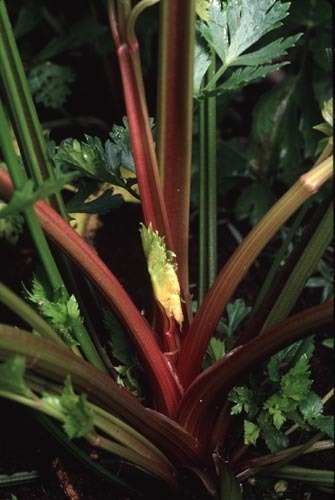
This crispy stem vegetable is a member of the carrot family. It is the same species as the similarly named Celeriac, which is eaten for its swollen lower stem, rather than its long green stems and/or leaves. Both are Apium graveolens and therefore both can be treated similarly in terms of growing conditions and seed starting. The seed itself is also used as an aromatic spice.
It originated in the Mediterranean basin rather like globe artichoke and asparagus – two other plants that we are exploring in this series of plant profiles as they are all require an early indoor start. It wandered far from its origins and is found growing wild in Europe and Asia wherever there is wet soils. Some of the earliest references to celery include medical usage. Many members of the carrot family, in fact, have bioactive agents including some being poisonous such as hemlock! This is why foragers are taught to be careful when identifying wild members of Apiaceae. It was also used for its distinctive taste as a flavouring. Wild or semi-wild selections of celery (smallage) are still used that way, much like its perennial relative Lovage.
The celery that most people are familiar is the green, fibrous stalk that is used as a dipping wand, element of crunch or vegetable-herb in to soups and stews. The stems are thick and grown tightly together so that the core of the plant is often semi-blanched, therefore milder in flavour.
Redventure is an OSSI selection of red-stemmed celery, bred by Frank Morton, by crossing the resilient Ventura celery with Giant Red. In this way, the progeny inherit all the flash and colour, as well as being easier to grow.
Start celery 10-12 weeks before last frost date and aim to plant out after the soil has warmed and temperatures have moderated or sometime in May. They will tolerate cooler temperatures but too much cold may trigger this biennial to think it has undergone winter so that it will go to flower, ending the production of leafy stems. Just like many other members of the carrot family (Apiaceae), it helps to soak them overnight before sowing. Celery seeds are tiny, and most sources say that they need light to germinate so you’ll want to surface sow and make sure the seeding substrate stays moist. These are high resource plants so put in a spot that has rich soil, is well watered, weeded and gets full sun.
Redventure celery is another beautiful plant that would fit in well in a decorative, edible landscape.
To learn more about OSSI – Open Seed Source Initiative